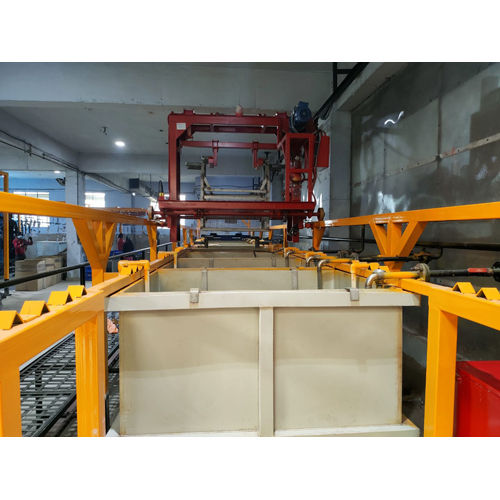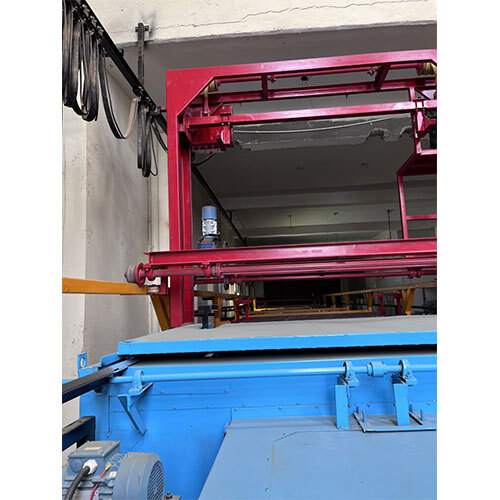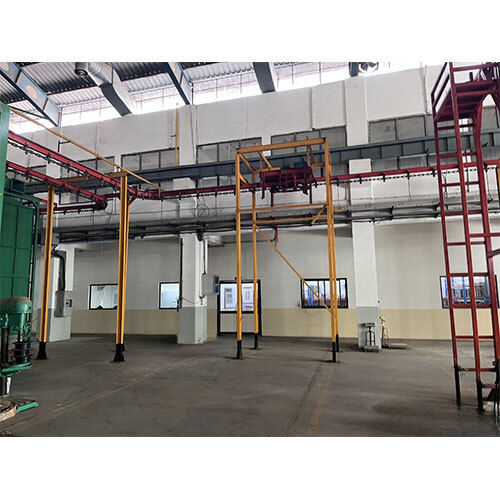Welcome to Our Comapny

Pre Treatment Dip Line
25,00,000 INR/Unit
Product Details:
- Type Pre Treatment Dip Line
- Material Stainless Steel
- Computerized No
- Automatic Grade Semi-Automatic
- Control System Frequency Speed Control
- Drive Type Electric
- Click to view more
X
Pre Treatment Dip Line Price And Quantity
- 1 Unit
- 25,00,000 INR/Unit
Pre Treatment Dip Line Product Specifications
- Electric
- Stainless Steel
- No
- Semi-Automatic
- Frequency Speed Control
- Pre Treatment Dip Line
Pre Treatment Dip Line Trade Information
- 1 Unit Per Month
- 30-90 Days
- All India
Product Description
Pre Treatment Dip Line is used in various industries, including textile and metal finishing, for preparing surfaces before further treatment or coating processes. This line involves immersing the objects or components into chemical baths or tanks to remove impurities, oils, rust, or any unwanted substances from the surface. The offered dip line is designed to ensure thorough and consistent treatment of the objects, enhancing adhesion, corrosion resistance, and overall quality of subsequent processes. With precise control over chemical concentrations, immersion times, and rinsing processes, this machine plays a crucial role in achieving optimal surface preparation and enhancing the performance and durability of the treated objects.
Applications of Pre Treatment Dip Line:
1. Metal Surface Preparation: In metal manufacturing, a pre-treatment dip line might involve immersing metal parts in a solution to remove contaminants, oils, and rust from the surface. This prepares the metal for subsequent processes like painting, coating, or plating.
2. Painting and Coating: Before applying paint or other coatings to a surface, its often necessary to ensure proper adhesion. A pre-treatment dip line could involve immersing the objects in a solution that removes impurities and provides a clean surface for the coating to adhere to.
3. Galvanization: Galvanization is the process of applying a protective zinc coating to steel or iron to prevent rusting. A pre-treatment dip line in this context could involve cleaning the metal surfaces and preparing them for the galvanization process.
4. Anodizing: Anodizing is an electrochemical process that enhances the thickness and properties of the natural oxide layer on metal surfaces, particularly aluminum. A pre-treatment dip line might include cleaning and preparing the aluminum before anodizing to ensure a consistent and high-quality finish.
5. Textile Dyeing: Before dyeing textiles, its important to prepare the fabric to ensure even color distribution. A pre-treatment dip line in the textile industry could involve treating the fabric with solutions to remove sizing, oils, and other impurities that could affect the dyeing process.
6. Electronics Manufacturing: In electronics manufacturing, some components might need to be cleaned or treated before assembly to ensure proper functioning and longevity. A pre-treatment dip line could involve cleaning or applying protective coatings to components.
7. Wood Treatment: In industries involving wood products, a pre-treatment dip line might involve applying preservatives, stains, or coatings to wood surfaces before further processing or finishing.
8. Printed Circuit Board (PCB) Manufacturing: Before assembling electronic components onto a PCB, the boards surface might need treatment to improve solderability and adhesion. A pre-treatment dip line could involve cleaning and possibly applying a surface finish like HASL (Hot Air Solder Leveling) or ENIG (Electroless Nickel Immersion Gold).
9. Automotive Industry: In automobile manufacturing, parts like chassis components might undergo pre-treatment dipping to enhance corrosion resistance and paint adhesion.
10. Medical Device Manufacturing: Certain medical devices require surface treatments for biocompatibility or sterilization purposes. A pre-treatment dip line could be employed to apply coatings or treatments that fulfill these requirements.
Benefits of Pre Treatment Dip Line:
1. Surface Preparation: Pre-treatment dip lines are primarily used to clean and prepare surfaces before subsequent processes like painting, coating, plating, or bonding. By removing contaminants, oils, rust, and other impurities, the treatment ensures proper adhesion and enhances the quality of the final product.
2. Enhanced Adhesion: Immersing materials in a pre-treatment solution improves the bonding between the surface and subsequent layers, such as paints, coatings, or adhesives. This leads to better adhesion, longer-lasting finishes, and improved overall product durability.
3. Corrosion Resistance: In industries where corrosion resistance is crucial, pre-treatment dip lines can apply protective coatings that inhibit rust and corrosion. These treatments extend the lifespan of products, especially those exposed to harsh environmental conditions.
4. Consistent Coating Application: Pre-treatment dip lines ensure a uniform and consistent application of coatings, paints, or other surface treatments. This helps eliminate irregularities, streaks, or variations in finish appearance.
5. Improved Appearance: By removing imperfections from the surface and facilitating better paint or coating adhesion, pre-treatment dip lines contribute to a smoother, more aesthetically pleasing finish on products.
6. Surface Activation: In certain manufacturing processes, materials need their surfaces activated before subsequent steps, such as bonding or printing. Pre-treatment dip lines can modify the surface chemistry to promote better interactions with other materials.
7. Waste Reduction: Proper pre-treatment can lead to better utilization of subsequent processing materials. For example, in coating applications, if the surface is adequately prepared, the coating material is less likely to be wasted due to uneven application or poor adhesion.
8. Reduced Rejection Rates: With proper pre-treatment, the likelihood of defects, such as peeling coatings or uneven finishes, is minimized. This results in lower rejection rates and improved product quality control.
9. Cost Efficiency: Implementing a pre-treatment dip line can lead to cost savings over time. By enhancing the longevity and quality of products, companies may reduce maintenance, warranty claims, and the need for frequent rework.
10. Environmental Considerations: Some pre-treatment processes can also contribute to environmentally friendly manufacturing. For instance, using eco-friendly chemicals and reducing the need for post-processing treatments can lead to a smaller environmental footprint.
11. Regulatory Compliance: In industries where regulations mandate certain quality standards, pre-treatment dip lines can help ensure that products meet these standards by preparing them appropriately for subsequent processes.
12. Versatility: Pre-treatment dip lines can be adapted to a wide range of materials, including metals, plastics, textiles, and more. This versatility makes them suitable for diverse manufacturing environments.
FAQs ofPre Treatment Dip Line:
Q. What is a Pre Treatment Dip Line?
Ans: A Pre Treatment Dip Line is an industrial process where materials or products are immersed in a solution or bath before undergoing further processing. The purpose of this treatment is to clean, prepare, or modify the surface of the material to improve adhesion, corrosion resistance, and overall quality in subsequent manufacturing steps.
Q. What is the purpose of pre-treatment in manufacturing?
Ans: The purpose of pre-treatment in manufacturing is to ensure that surfaces are properly cleaned, prepared, or modified before undergoing processes like painting, coating, plating, bonding, or other treatments. This improves the quality, durability, and appearance of the final product by enhancing adhesion, corrosion resistance, and overall performance.
Q. What industries commonly use Pre Treatment Dip Lines?
Ans: Pre Treatment Dip Lines are used across various industries, including metal fabrication, automotive, aerospace, electronics, textiles, wood processing, and more. Any industry that requires clean and well-prepared surfaces before further processing can benefit from these lines.
Q. What types of treatments are applied using Pre Treatment Dip Lines?
Ans: Common treatments applied using Pre Treatment Dip Lines include cleaning, surface activation, applying protective coatings (e.g., anti-corrosion coatings), and enhancing adhesion properties for subsequent processes.
Q. What are the benefits of using a Pre Treatment Dip Line?
Ans: The benefits include enhanced adhesion, improved corrosion resistance, better surface preparation, reduced rejection rates, consistent coating application, cost efficiency, improved product appearance, and compliance with quality standards.
Q. What materials can be treated using Pre Treatment Dip Lines?
Ans: Pre Treatment Dip Lines can be used for various materials such as metals (steel, aluminum, etc.), plastics, textiles, wood, and even some ceramics. The specific treatment and chemistry might vary based on the material type.
Q. What chemicals are used in Pre Treatment Dip Lines?
Ans: The chemicals used depend on the treatment required and the material being processed. Commonly used chemicals include degreasers, alkaline cleaners, acid solutions, conversion coatings, and protective coatings. The choice of chemicals is influenced by factors like the materials composition and the desired outcome.
Q. What safety precautions are needed when operating Pre Treatment Dip Lines?
Ans: Safety precautions include using appropriate personal protective equipment (PPE), ensuring proper ventilation in the workspace, handling chemicals in accordance with safety guidelines, and training personnel in handling hazardous substances.
Q. How can the efficiency of a Pre Treatment Dip Line be optimized?
Ans: Efficiency can be optimized by regularly maintaining equipment, monitoring chemical concentrations, ensuring consistent immersion times, and employing quality control measures to prevent defects.
Q. Does every manufacturing process require pre-treatment?
Ans: Not every process requires pre-treatment, but its commonly used when the quality, appearance, and longevity of the final product are critical. The necessity of pre-treatment depends on factors like the material, process, and desired outcome.
Q. Can Pre Treatment Dip Lines be automated?
Ans: Yes, Pre Treatment Dip Lines can be automated to ensure consistent and precise treatment. Automation can also improve process efficiency and reduce the potential for human error.
Q. Are there environmentally friendly pre-treatment options?
Ans: Yes, there are environmentally friendly pre-treatment options that use eco-friendly chemicals and processes. These options aim to minimize the environmental impact of manufacturing operations.
FAQs of Pre Treatment Dip Line:
Q: What is Pre Treatment Dip Line?
A: Pre Treatment Dip Line is a type of equipment used in industrial processes to clean and prepare surfaces before applying coatings or paints.Q: Is Pre Treatment Dip Line computerized?
A: No, Pre Treatment Dip Line is not computerized.Q: What is the automatic grade of Pre Treatment Dip Line?
A: Pre Treatment Dip Line is a semi-automatic equipment.Q: What is the material used in Pre Treatment Dip Line?
A: Pre Treatment Dip Line is made of stainless steel material.Q: What is the drive type of Pre Treatment Dip Line?
A: Pre Treatment Dip Line uses an electric drive type.Q: What is the control system used in Pre Treatment Dip Line?
A: Pre Treatment Dip Line uses a frequency speed control system.Q: What is the purpose of using Pre Treatment Dip Line?
A: Pre Treatment Dip Line is used to remove contaminants and prepare surfaces for coating or painting in industrial processes.Tell us about your requirement

Price:
Quantity
Select Unit
- 50
- 100
- 200
- 250
- 500
- 1000+
Additional detail
Mobile number
Email







 Call Me Free
Call Me Free
 English
English Spanish
Spanish French
French German
German Italian
Italian Chinese (Simplified)
Chinese (Simplified) Japanese
Japanese Korean
Korean Arabic
Arabic Portuguese
Portuguese